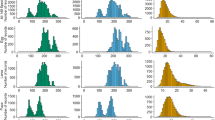Abstract
Nesidiocoris tenuis Reuter (Hemiptera: Miridae) is a polyphagous mirid currently used for the control of leafminers, thrips, whitefly and spider mites in Mediterranean regions to which it is indigenous. This study investigates the establishment potential of N. tenuis in cool temperate climates typical of northern Europe through assessment of its thermal biology and low temperature tolerance in laboratory and field experiments. The developmental threshold of N. tenuis was estimated to be 12.9°C with no indication of ability to diapause. Supercooling points of the acclimated and non-acclimated adults and nymphs of the mirid were between −17.6° and −21.5°C and the LTemp50 was around −12°C, indicating a high level of pre-freeze mortality. The LTime50 at 5°C was nine days and 100% mortality occurred after less than four weeks of winter field exposure. Collectively these data suggest that N. tenuis is unlikely to establish in northern Europe and would therefore have little or no non-target effects on native species in such regions.






Similar content being viewed by others
References
Bale JS, O’Doherty R, Atkinson HA, Stevenson RA (1984) An automatic thermoelectric cooling method and computer-based recording-system for supercooling point studies on small invertebrates. Cryobiology 21:340–347
Calvo J, Urbaneja A (2003) Nesidiocoris tenuis Reu. (Heteroptera: Miridae) en tomate: ¿Amigo o Enemigo? Almería Verde 4:21–23
Cory JS, Myers JH (2000) Direct and indirect ecological effects of biological control. Trends Ecol Evol 15:137–139
Draper NR, Smith H (1981) Applied regression analysis. John Wiley and Sons, New York
Finney DJ (1971) Probit analysis. University Press, Cambridge
Gillespie DR, Sanchez JAS (2004) Cumulative temperature requirements and development thresholds in two populations of Dicyphus hesperus (Hemiptera: Miridae). Can Entomol 136:675–683
Hart AJ, Bale JS, Tullett AG, Worland MR, Walters KFA (2002a) Effects of temperature on the establishment potential of the predatory mite Amblyseius californicus McGregor (Acari: Phytoseiidae) in the UK. J Insect Physiol 48:593–599
Hart AJ, Tullett AG, Bale JS, Walters KFA (2002b) Effects of temperature on the establishment potential in the U.K. of the non-native glasshouse biological control agent Macrolophus caliginosus. Physiol Entomol 27:112–123
Hatherley IS, Bale JS, Walters KFA, Worland MR (2003) Thermal biology of Typhlodromips montdorensis: implications for its introduction as a glasshouse biological control agent in the UK. Entomol Exp Appl 111:97–109
Hatherley IS, Hart AJ, Tullett AG, Bale JS (2005) Use of thermal data as a screen for the establishment potential of non-native biological control agents in the UK. BioControl 50:687–698
Hatherley IS, Pedersen BP, Bale JS (2008) Establishment potential of the predatory mirid Dicyphus hesperus in northern Europe. BioControl 53:589–601
Jolly RJ (2000) The predatory mite Neoseiulus californicus: its potential as a biological control agent for the fruit tree red spider mite Panonychus ulmi in the UK. Proceedings of the 2000 Brighton Conference—Pests & Diseases 2000 1: 487–490
Loomans AJM (2007) Regulation of invertebrate Biological Control Agents in Europe: review and recommendations in its pursuit of a harmonised regulatory system. Regulation of Biological Control Agents, Report EU project REBECA
Majerus MEN, Strawson V, Roy HE (2006) The potential impacts of the arrival of the Harlequin ladybird, Harmonia axyridis (Pallas) (Coleoptera: Coccinellidae), in Britain. Ecol Entomol 31:207–215
Olsen A, Bale JS, Leadbeater BSC, Callow ME, Holden JB (2003) Developmental thresholds and day-degree requirements of Paratanytarsus grimmii and Corynoneura scutellata (Diptera: Chironomidae): two midges associated with potable water treatment. Physiol Entomol 28:315–322
Ryckewaert P, Alauzet C (2002) The natural enemies of Bemisia argentifolii in Martinique. BioControl 47:115–126
Tullett AG (2002) Methodologies for assessing the effects of low temperature on the establishment potential of non-native arthropods. PhD thesis, University of Birmingham, 2002. 66–79
Tullett AG, Hart AJ, Worland MR, Bale JS (2004) Assessing the effects of low temperature on the establishment potential in Britain of the non-native biological control agent Eretmocerus eremicus. Physiol Entomol 29:363–371
Urbaneja A, Tapia G, Stansly P (2005) Influence of host plant and prey availability on developmental time and survivorship of Nesidiocoris tenuis (Het.: Miridae). Biocontrol Sci Techn 15:513–518
Vacante V, Garzia G (1994) Indagini sul ruolo ecologico di Nesidiocoris tenuis (Reuter) nelle serre fredde di pomodoro del Ragusano. Inform Fitopatologico 9:45–48
Van Lenteren JC, Loomans AJM (2006) Environmental risk assessment: methods for comprehensive evaluation and quick scan. In: Bigler F, Babendreier D, Kuhlmann U (eds) Environmental impact of invertebrates for biological control of arthropods: methods, risk assessment. CAB Int, Wallingford, pp 254–272
Van Lenteren JC, Bale J, Bigler F, Hokkanen HMT, Loomans AJM (2006) Assessing risks of releasing biological control agents of athropod pests. Annu Rev Entomol 51:609–634
Acknowledgments
Gwennan E. Hughes was funded by the Biotechnology and Biological Sciences Research Council (BBSRC) in a CASE studentship with Biobest Belgium.
Author information
Authors and Affiliations
Corresponding author
Additional information
Handling Editor: Patrick De Clercq.
Rights and permissions
About this article
Cite this article
Hughes, G.E., Bale, J.S. & Sterk, G. Thermal biology and establishment potential in temperate climates of the predatory mirid Nesidiocoris tenuis . BioControl 54, 785–795 (2009). https://doi.org/10.1007/s10526-009-9230-0
Received:
Accepted:
Published:
Issue Date:
DOI: https://doi.org/10.1007/s10526-009-9230-0




